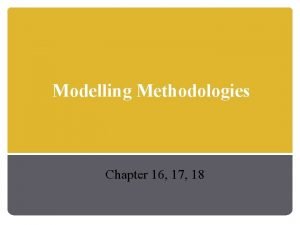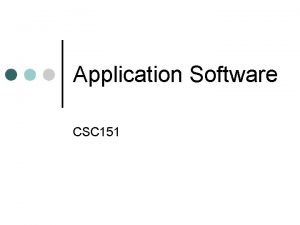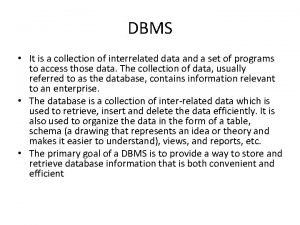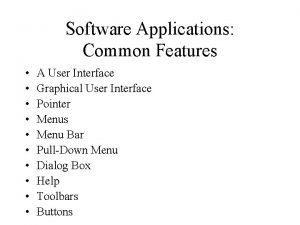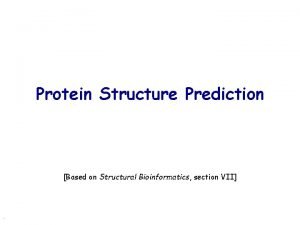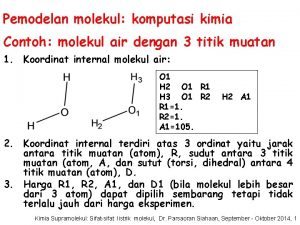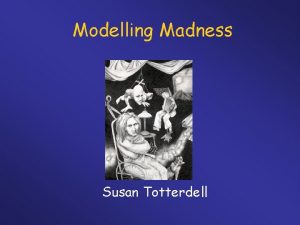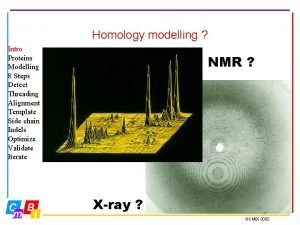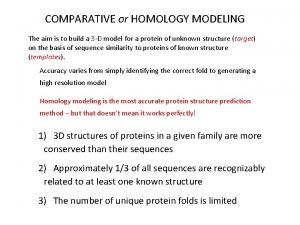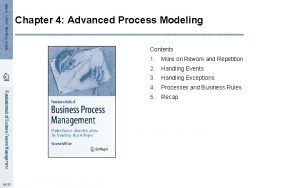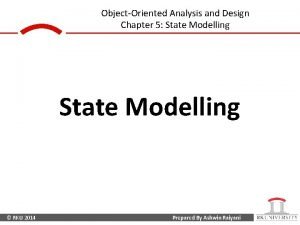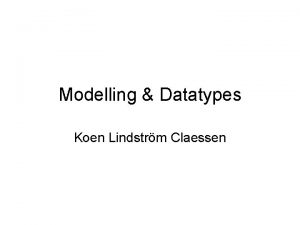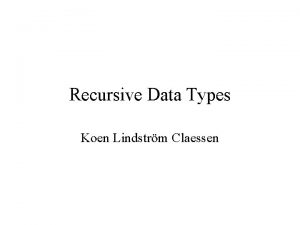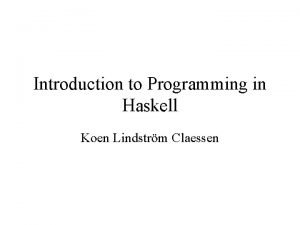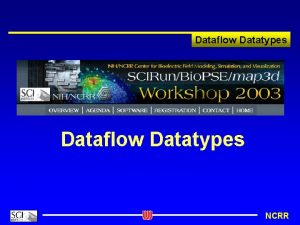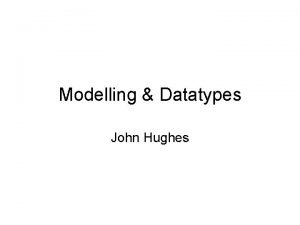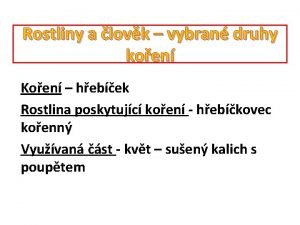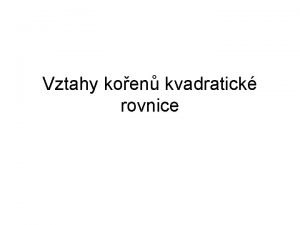Modelling Datatypes Koen Lindstrm Claessen Software Programs Data
















































![Lists • Can represent 0, 1, 2, … things – [], [3], [”apa”, ”katt”, Lists • Can represent 0, 1, 2, … things – [], [3], [”apa”, ”katt”,](https://slidetodoc.com/presentation_image/0176673c8bfc05d4c8fd8e4d82663d01/image-49.jpg)





- Slides: 54

Modelling & Datatypes Koen Lindström Claessen

Software = Programs + Data

Modelling Data • A big part of designing software is modelling the data in an appropriate way • Numbers are not good for this! • We model the data by defining new types

Modelling a Card Game • Every card has a suit Hearts, Whist, Plump, Bridge, . . . • Model by a new type: data Suit = Spades | Hearts | Diamonds | Clubs The new type The values of this type

Investigating the new type Main> : i Suit -- type constructor data Suit -- constructors: Spades : : Suit Hearts : : Suit Diamonds : : Suit Clubs : : Suit Main> : i Spades : : Suit -- data constructor The new type The new values -- constructors Types and constructors start with a capital letter

Printing Values Main> Spades ERROR - Cannot find "show" function for: *** Expression : Spades Needed to print *** Of type : Suit values Main> : i show : : Show a => a -> String -- class member • Fix data Suit = Spades | Hearts | Diamonds | Clubs deriving Show Main> Spades

The Colours of Cards • Each suit has a colour – red or black • Model colours by a type data Colour = Black | Red deriving Show • Define functions by pattern matching colour : : Suit -> Colour colour Spades = Black colour Hearts = Red colour Diamonds = Red colour Clubs = Black One equation per value Main> colour Hearts Red

The Ranks of Cards • Cards have ranks: 2. . 10, J, Q, K, A • Model by a new type Numeric ranks data Rank = Numeric Integer | Jack | Queen | King | Ace deriving Show Numeric ranks contain an Integer Main> : i Numeric : : Integer -> Rank -- data constructor Main> Numeric 3

Rank Beats Rank • When does one rank beat another? A K Q J m m>n n J Q K A

Rank Beats Rank rank. Beats : : Rank -> Bool

Rank Beats Rank • When does one rank beat another? A K Q J m m>n n J Q K A

Rank Beats Rank rank. Beats : : Rank -> Bool

Rank Beats Rank • When does one rank beat another? A K Q J m m>n n J Q K A

Rank Beats Rank rank. Beats : : Rank -> Bool

Rank Beats Rank • When does one rank beat another? A K Q J m m>n n J Q K A

Rank Beats Rank rank. Beats : : Rank -> Bool rank. Beats _ Ace = False Matches anything at all Nothing beats an Ace

Rank Beats Rank • When does one rank beat another? A K Q J m m>n n J Q K A

Rank Beats Rank rank. Beats : : Rank -> Bool rank. Beats _ Ace = False An Ace beats anything else rank. Beats Ace _ = True Used only if the first equation does not match.

Rank Beats Rank • When does one rank beat another? A K Q J m m>n n J Q K A

Rank Beats Rank rank. Beats : : Rank -> Bool rank. Beats _ Ace = False rank. Beats Ace _ = True rank. Beats _ King = False rank. Beats King _ = True

Rank Beats Rank • When does one rank beat another? A K Q J m m>n n J Q K A

Rank Beats Rank rank. Beats : : Rank -> Bool rank. Beats _ Ace = False rank. Beats Ace _ = True rank. Beats _ King = False rank. Beats King _ = True rank. Beats _ Queen = False rank. Beats Queen _ = True rank. Beats _ Jack = False rank. Beats Jack _ = True

Rank Beats Rank • When does one rank beat another? A K Q J m m>n n J Q K A

Rank Beats Rank rank. Beats : : Rank -> Bool rank. Beats _ Ace = False rank. Beats Ace _ = True rank. Beats _ King = False rank. Beats King _ = True rank. Beats _ Queen = False rank. Beats Queen _ = True rank. Beats _ Jack = False rank. Beats Jack _ = True rank. Beats (Numeric m) (Numeric n) = m > n Match Numeric 7, for example Names the number in the rank

Examples Main> rank. Beats Jack (Numeric 7) True Main> rank. Beats (Numeric 10) Queen False

A Property • Either a beats b or b beats a prop_rank. Beats a b = rank. Beats a b || rank. Beats b a Main> quick. Check prop_rank. Beats ERROR - Cannot infer instance *** Instance : Arbitrary Rank *** Expression : quick. Check prop_rank. Beats Quick. Check doesn’t know how to choose an arbitrary Rank!

Generators • Test data is chosen by a test data generator • Writing generators we leave for the future

Testing the Property prop_rank. Beats a b = rank. Beats a b || rank. Beats b a Main> quick. Check prop_rank. Beats Falsifiable, after 9 tests: King Provided they’re not equal prop_rank. Beats a b = a/=b ==> rank. Beats a b || rank. Beats b a data Rank = Numeric Integer | Jack | Queen | King | Ace deriving (Show, Eq) Define == for ranks

Modelling a Card • A Card has both a Rank and a Suit data Card = Card Rank Suit deriving Show • Define functions to inspect both rank : : Card -> Rank rank (Card r s) = r suit : : Card -> Suit suit (Card r s) = s

A Useful Abbreviation • Define type and inspection functions together, as follows data Card = Card {rank : : Rank, suit : : Suit} deriving Show

When does one card beat another? • When both cards have the same suit, and can be written the rank is higher down simpler. . . card. Beats : : Card -> Bool card. Beats c c' | suit c == suit c' = rank. Beats (rank c) (rank c') | otherwise = False data Suit = Spades | Hearts | Diamonds | Clubs deriving (Show, Eq)

When does one card beat another? • When both cards have the same suit, and the rank is higher card. Beats : : Card -> Bool card. Beats c c' = suit c == suit c’ && rank. Beats (rank c) (rank c')

Testing card. Beats • Test the same property for cards prop_card. Beats a b = card. Beats a b || card. Beats b a

Testing card. Beats • Test the same property for cards Main> quick. Check prop_card. Beats Falsifiable, after 0 tests: Card{rank=Numeric 7, suit=Hearts} Card{rank=Numeric 6, suit=Clubs} • Of course! In general, the card played first wins! property does not hold!

Modelling a Hand of Cards • A hand may contain any number of cards from zero up! data Hand = Cards Card … Card deriving Show • The solution is… recursion! We can’t use …!!!

Modelling a Hand of Cards • A hand may contain any number of cards from zero up! – A hand may be empty very much like a – It may consist of a first card and the restlist. . . • The rest is another hand of cards! data Hand = Empty | Add Card Hand deriving Show A recursive type! Solve the problem of modelling a hand with one fewer cards!

When can a hand beat a card? • An empty hand beats nothing • A non-empty hand can beat a card if the first card can, or the rest of the hand can! hand. Beats : : Hand -> Card -> Bool hand. Beats Empty card = False hand. Beats (Add c h) card = card. Beats c card || hand. Beats h card • A recursive function!

Choose a card to play • Given – Card to beat – The hand • Beat the card if possible!

Strategy • If the hand is only one card, play it • If there is a choice, – Select the best card from the rest of the hand – Choose between it and the first card • Principles – Follow suit if possible – Play lowest winning card if possible – Play lowest losing card otherwise

The Code -- choose. Card trump beat hand chooses a card from hand to -- play, when trump is the trump suit and beat is the card to -- be beaten choose. Card : : Card -> Hand choose. Card beat (Add c Empty) = c choose. Card beat (Add c rest) | suit c==suit beat && suit c’/=suit beat = c | suit c/=suit beat && suit c’==suit beat = c’ | rank. Beats (rank c) (rank c’) = c’ | otherwise =c where c’ = choose. Card trump beat rest

Properties of choose. Card • Complicated code with great potential for errors! • Possible properties: – choose. Card returns a card from the hand (”no cards up the sleeve”) – choose. Card follows suit if possible (”no cheating”) – choose. Card always wins if possible

Testing choose. Card prop_choose. Card. Wins. If. Possible c h = h/=Empty ==> hand. Beats h c == card. Beats (choose. Card c h) c Main> quick. Check prop_choose. Card. Wins. If. Possible Falsifiable, after 3 tests: Card{rank=Numeric 8, suit=Diamonds} Add Card{rank=Numeric 4, suit=Diamonds} (Add Card{rank=Numeric 10, suit=Spades} Empty) What went wrong?

What Did We Learn? • Modelling the problem using datatypes with components • Using recursive datatypes to model things of varying size • Using recursive functions to manipulate recursive datatypes • Writing properties of more complex algorithms

Reminder: Modelling a Hand • A Hand is either: – An empty hand – Formed by adding a card to a smaller hand data Hand = Empty | Add Card Hand deriving Show • Discarding the first card: discard : : Hand -> Hand discard (Add c h) = h

Lists -- how they work

Lists data List = Empty | Add ? ? List • A list is either: – An empty list – Formed by adding an element to a smaller list • What to put on the place of the ? ?

Lists data List a = Empty | Add a (List a) • A type parameter • Add 12 (Add 3 Empty) : : List Integer • Add ”apa” (Add ”bepa” Empty) : : List String

Lists data List a = Empty | Add a (List a) • • Empty : : List Integer Empty : : List Bool Empty : : List String. . .
![Lists Can represent 0 1 2 things 3 apa katt Lists • Can represent 0, 1, 2, … things – [], [3], [”apa”, ”katt”,](https://slidetodoc.com/presentation_image/0176673c8bfc05d4c8fd8e4d82663d01/image-49.jpg)
Lists • Can represent 0, 1, 2, … things – [], [3], [”apa”, ”katt”, ”val”, ”hund”] • They all have the same type – [1, 3, True, ”apa”] is not allowed • The order matters – [1, 2, 3] /= [3, 1, 2] • Syntax – 5 : (6 : (3 : [])) == 5 : 6 : 3 : [] == [5, 6, 3] – ”apa” == [’a’, ’p’, ’a’]

More on Types • Functions can have ”general” types: – polymorphism – reverse : : [a] -> [a] – (++) : : [a] -> [a] • Sometimes, these types can be restricted – Ord a => … for comparisons (<, <=, >, >=, …) – Eq a => … for equality (==, /=) – Num a => … for numeric operations (+, -, *, …)

Do’s and Don’ts is. Big : : Integer -> Bool is. Big n | n > 9999 = True | otherwise = False guards and boolean results is. Big : : Integer -> Bool is. Big n = n > 9999

Do’s and Don’ts result. Is. Small : : Integer -> Bool result. Is. Small n = is. Small (f n) == True comparison with a boolean constant result. Is. Small : : Integer -> Bool result. Is. Small n = is. Small (f n)

Do’s and Don’ts result. Is. Big : : Integer -> Bool result. Is. Big n = is. Small (f n) == False comparison with a boolean constant result. Is. Big : : Integer -> Bool result. Is. Big n = not (is. Small (f n))

Writing Code • Beautiful code – readable – not overly complicated – no repetitions – no ”junk” left • For – you – other people
 Petra claessen neerpelt
Petra claessen neerpelt Rob claessen
Rob claessen Disadvantages of waterfall model in software engineering
Disadvantages of waterfall model in software engineering Modelling software
Modelling software Consequence modelling software
Consequence modelling software Unit 5 data modelling assignment 2
Unit 5 data modelling assignment 2 Data modelling techniques in business intelligence
Data modelling techniques in business intelligence Trendlines and regression analysis
Trendlines and regression analysis Define the relationship chapter 16
Define the relationship chapter 16 Power platform data modelling
Power platform data modelling Example of data processing cycle
Example of data processing cycle Peter vangorp
Peter vangorp Koen korevaar
Koen korevaar Koen hoondert
Koen hoondert Dokter koen thomeer
Dokter koen thomeer Koen de boeck
Koen de boeck Dr koen peeters
Dr koen peeters Koen dewulf west-vlaanderen
Koen dewulf west-vlaanderen Koen titeca
Koen titeca Lembaga dan pranata sosial
Lembaga dan pranata sosial Koen vancraeynest
Koen vancraeynest Dr koen van besien
Dr koen van besien Koen van deun
Koen van deun Marielle hoeijmans
Marielle hoeijmans Catering sales software
Catering sales software Unlike application software programs
Unlike application software programs Software consists of...
Software consists of... Categories of software in computer
Categories of software in computer Vending software programs
Vending software programs Corel ventura illustrator are examples of
Corel ventura illustrator are examples of Collection of interrelated data is called
Collection of interrelated data is called Programs that organize analyze and graph numerical data
Programs that organize analyze and graph numerical data Open data programs
Open data programs Algorithms + data structures = programs
Algorithms + data structures = programs Common features of software
Common features of software Technological modelling
Technological modelling Homology modelling steps
Homology modelling steps Giuliano casale
Giuliano casale Molecular modelling laboratory
Molecular modelling laboratory Modelling madness
Modelling madness Richer interaction in hci
Richer interaction in hci Lbo model case study
Lbo model case study Geometric modeling in cad
Geometric modeling in cad Homology modelling steps
Homology modelling steps Hair modelling
Hair modelling Objective of edlc
Objective of edlc Homology modelling steps
Homology modelling steps Exercise 4
Exercise 4 Mathematical modeling of electrical systems examples
Mathematical modeling of electrical systems examples Flight level
Flight level Graphical modelling tool for structured analysis
Graphical modelling tool for structured analysis Algorithmic cost modelling
Algorithmic cost modelling Class responsibility collaborator modelling
Class responsibility collaborator modelling State modelling
State modelling Object oriented modelling
Object oriented modelling








